The main thing in the renovation is the finishing of the walls in the kitchen. It is necessary to choose finishing materials practical and beautiful, and it is not easy: not all meet the requirements.
Contents of the article
Requirements for finishing materials for the kitchen
Kitchen refers to rooms with difficult conditions: there is often high humidity, vapors, splashes of grease. Therefore, materials for finishing kitchen walls should be well washable, should not react to high humidity.
In addition to cooking in most families in the kitchen is still used as a dining room. And if so, then the finish should also be beautiful. Naturally, it should be safe for health and, preferably, durable.
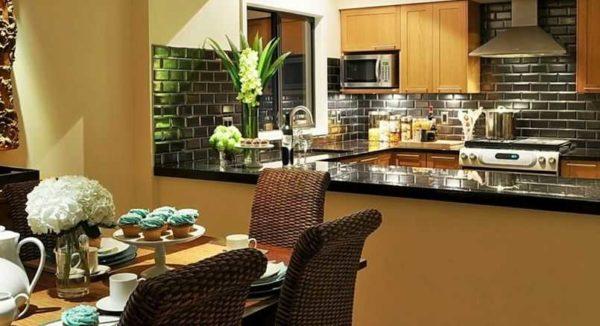
Satisfies all the conditions not so many materials. Saves only a large variety of textures and colors, and recently appeared novelties. So, finishing the walls in the kitchen is carried out with the help of:
- ceramic tiles and mosaics;
- washable wallpaper;
- waterproof paint;
- MDF panels, plastic;
- decorative plaster.
Because of the fact that one room combines different functions, even a small kitchen is divided into two zones – working and dining. And emphasizes the division of the use of different finishing materials, including for the walls. So most often have to choose two types of wall finishes for the kitchen – in the working area something very practical, easy to clean, and in the dining area in the same style and color, but more cozy.
Ceramic tiles and mosaics
Wall ceramic tiles for finishing the walls of the kitchen – an excellent option in terms of durability and ease of care. But if the whole room is tiled, it will be uncomfortable, as in the operating room. Another disadvantage – high costs for the material itself and for its installation: to put tiles on the walls is not very easy, so more often hire masters, and their work is not cheap.
Therefore, in modern repair for the most part ceramics finished working area – the space of the wall between the floor and hanging cabinets. This piece is also called the kitchen apron. Previously, it was made only of tiles, today this material has decent competitors – glass ceramic and plastic panels, MDF panels, decorative and natural stone.
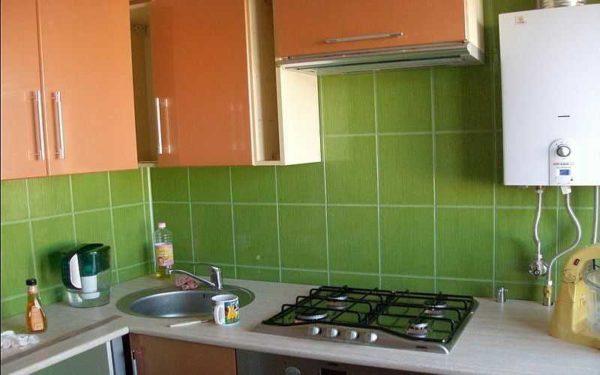
All new materials are easy to install – mounted on a few bolts, do not require a perfectly flat surface of the wall. It is also easier to care for them, because the seams are very few – at the joint of the panels – and they can be sealed with sealant to exclude moisture and dirt. In general, ceramic tiles – not a bad option for finishing the working area in the kitchen, but not the only and not the best.
Options for finishing with ceramic tiles
But despite the presence of new materials, tile is still the most popular option for finishing the working wall in the kitchen. Only in the style of decoration there are significant differences. Ubiquitous previously used medium-sized square tiles 15 * 15 cm or 18 * 18 cm is no longer popular. In favor of large formats – long rectangular or square, but with a side of at least 35 cm, or even 50-70 cm. So it turns out that the kitchen apron requires one or two rows of tiles.
What exactly to choose a tile – smooth, with texture, with pictures or without – it’s up to you. Textured, of course, looks very interesting. But in practicality it is inferior to a smooth surface: in the recesses clogged dirt and soot. To bring it to a normal state requires considerable effort.
Finishing walls with mosaic
Well looks finishing the walls in the kitchen mosaic. This is a very small ceramic, glass ceramic or glass tiles, glued on a grid – for faster installation. Small squares can be the same color, and can – different shades in the same range, there is a mosaic, lined with patterns and even paintings. This type of finishing material is even more expensive than ceramic tile, but the look of it is not standard.
Finish mosaic in the kitchen can not only the working wall. The same panel is made over the dining table. This harmonizes the interior. In addition, another often dirty zone gets an easily washable coating.
Wallpaper: washable and paintable
This type of finishing material is mostly used on the walls in the dining area of the kitchen. In the working area, even super-washable and super-strong wallpaper will not last long. Especially in the area of the sink.
According to the technology of finishing the walls in the kitchen wallpaper involves first leveling the walls, on a level surface glue wallpaper. The best choice – with vinyl coating. Vinyl forms a dense film that can be wiped with a cloth. There are technologies that allow you to get such a durable coating that these wallpapers can be washed with a brush using liquid (not abrasive) detergents.
Vinyl wallpaper is paper-based, there are on fleece. Fleece on a flat surface are glued very easily. If the walls in the kitchen are not leveled, it is better to take vinyl wallpaper on a paper base, and paper choose a dense, and the surface of the roll – textured. This will help hide irregularities.
A separate category should be allocated wallpaper under painting. They should also be glued to a flat surface. They are made more often on the basis of fiberglass canvas. They are painted with water-based paint, without problems can be repainted from 3 to 20 times (depends on the type of wallpaper, the more you can repaint, the more expensive wallpaper). About the choice of paint will talk in the next section.
Another separate type of wallpaper – photo wallpaper. Bright or pastoral landscapes, city pictures, kitchen “still life” – whatever your heart desires. It is usually pasted on the wall where the table stands or on a free wall. There is, by the way, a way to blur the boundaries in a rectangular kitchen – to stick a large-format image with a visit to the neighboring wall. Immediately changes the visual perception of the room.
Wall painting
The choice of paint for walls in the kitchen is not so great – most of all suitable water emulsion, but you need to take them washable. This type of paint can be repainted without problems, but it is easier to wash. Therefore, we choose just such.
According to the technology of finishing the walls in the kitchen paint – on a level, pre-primed wall. The type of primer is chosen depending on the type of paint (with acrylates, alkyd and silicate). After the primer dries, paint is applied in several layers. Since the base is aqueous, there is practically no odor, after drying, a film of varying degrees of strength is formed (read more about paints for finishing here).
Finishing kitchen walls with paint can be background, dim, or, conversely, draw attention to itself. Background paints are chosen if the kitchen furniture set of bright colors, and bright walls are made if the facades are neutral.
Decorative plaster
Decorative plaster is also called “liquid wallpaper”. These compositions are textured and smooth. Smooth – Venetian plaster based on marble dust with various additives. To the touch the surface turns out silky, has a very similar to silk muted luster. There are two types of textured plaster. In the first relief is obtained due to the presence in the composition of some large inclusions (usually quartz sand of different granularity), the second relief is obtained due to the application of special rollers brushes, spatulas.
Finishing the walls in the kitchen smooth decorative plaster occurs after careful leveling of the walls. The composition is very expensive and spend it on the leveling of defects is extremely unprofitable. In addition, the slightest irregularities spoil the overall impression. Structural decorative plaster can be decorated non-ideal walls – the surface will still be uneven, so perfect smoothness is not required. What is mandatory in any case – pre-priming for better adhesion to the surface.
Decorative plaster for finishing the walls in the kitchen is a good choice – it is washable, for a long time retains its appearance, many pigments do not fade and do not burn out. The disadvantage – the high price of the material and a complex technique of application, with which not all “masters” can cope. In addition to the ability to plaster here requires artistic taste, and it is not everyone.
Natural and decorative stone
Non-standard design of walls in the kitchen is made with the use of natural or artificial decorative stone. Natural – sawed into thin plates of different sizes and shapes. Artificial – made on the basis of gypsum or cement, with the addition of crumbs of natural minerals. Natural stone is heavier and more expensive, it is more difficult to lay. Artificial is lighter in weight, much cheaper, easier to lay one side of it as a tile, the second imitates the surface of the stone and color and shape.
Finishing the walls in the kitchen decorative stone – natural or artificial – requires some skill. Preliminary is also required to level the surface before you start finishing work. Lay on the adhesive for tiles, first coating with primer. After laying the stone, the joints are expanded (with mortar or grout), after the wall is covered with varnish – to make it easier to care for.
Finishing the walls in the kitchen plastic panels
If you need an inexpensive and fast option for finishing the kitchen, consider wall plastic panels. They are mounted on a batten, fastened with self-tapping screws or staples from a stapler. The walls are not necessary to level – the batten will hide all the shortcomings. Finishing the walls in the kitchen PVC panels, probably the fastest way to update the room. In addition, the cheapest. Color options are very many – from solid-colored matte or glossy to imitation of tiles, wood and other surfaces and materials.
Naturally, there are disadvantages – unnatural raw materials and fragility. Raw materials are not natural, but under normal operating conditions (do not exceed the temperature) harmless. With brittleness. can not do anything – plastic panels have jumpers between the two layers of polymer. On impact, they crumple. There are, however, thin PVC wall panels, but they are glued on flat walls. In any case, if you need a quick and inexpensive way to update the wall covering in your kitchen – consider plastic panels.
MDF panels
Another easy and quick way to make repairs – finishing the walls in the kitchen with MDF panels. They are also mounted on a batten, but are much more expensive than plastic. One way to finish the apron without tiles is to use MDF boards. In addition, this material can be used to decorate the rest of the walls. It is made from flour-ground wood waste, which is molded at high pressure. The resulting boards are then laminated with a film. MDF colors can be very many, but the most popular are imitation wood of different species and shades.
There are different color solutions for decorating the walls in the kitchen with MDF panels:
- Choose the same color as on the countertop.
- Make the apron matching the facade, and the walls of a different color.
- All walls and apron in the kitchen make the same color, but it does not match the coloring of the furniture (contrasting or in the same range).
The disadvantage of this method of finishing kitchen walls – MDF reacts to high humidity (a little, but expands). To reduce the effect, during installation, open cuts are treated with sealant.

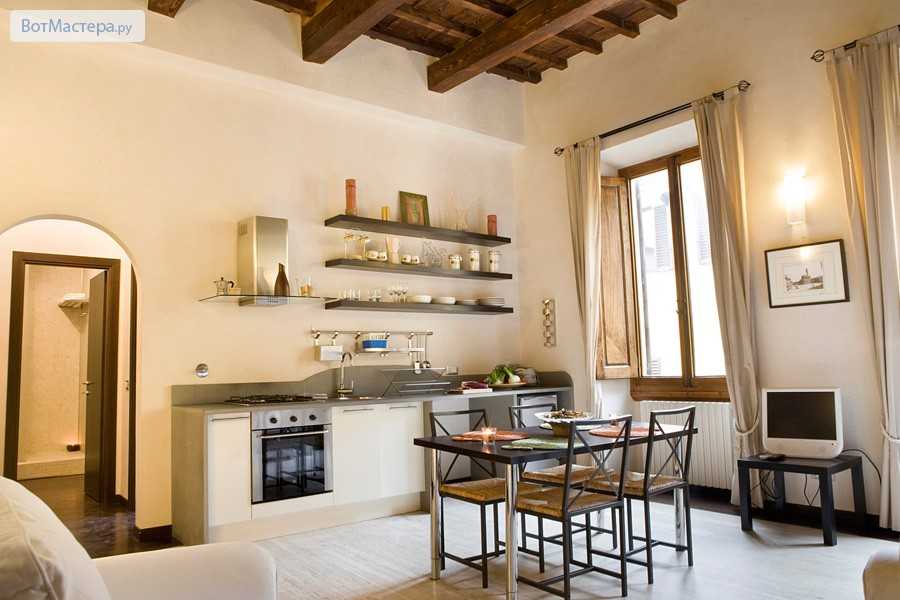
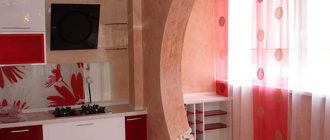
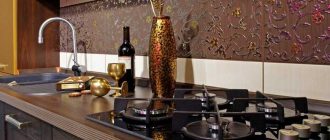
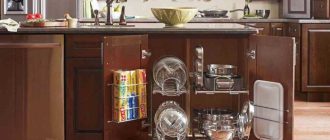
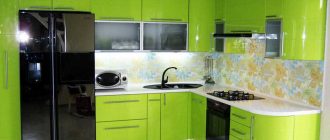
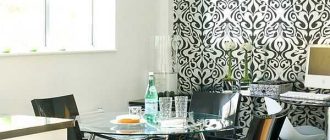
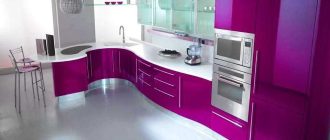
Oh wow, choosing kitchen wall finishes is such a game-changer! I went for subway tiles, and they look amazing with my color scheme. It totally elevates the vibe! Can’t wait to cook and show it off to friends. Seriously, you guys will love this!